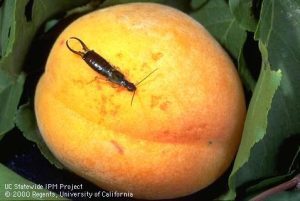Ants and Earwigs: Good Bugs Or Bad Bugs?
Gardeners often divide the insect world into two groups: “Good bugs” and “bad bugs.” Bad bugs are thought to bring disease and destruction, laying eggs by the dozens and sucking the life out of plants. Good bugs, on the other hand, march to the rescue and chow down on the bad guys.
But ants and earwigs, like many insects, have dual roles. Admittedly earwigs munching on newly sprouted salad greens and ants partying in the sugar bowl are a gardener’s call to action, but these insects are helpful as well.
ANTS: The vast number of ants contributes to the popularity of pest control services. They are the most abundant insects in both biomass and number of individuals, with about 600 ant species in the U.S. and Canada. Some ants damage young tree bark and certain crops.
Other ants disrupt biological control in orchards and gardens by protecting plant-damaging honeydew-producing insects from their enemies. These honeydew producers—including aphids, white flies, mealy bugs, and some scale—secrete a sweet honeydew that ants use for food.
On the plus side, nests of weaver ants are gathered and sold in citrus orchards in China because the ants prey on fruit-damaging insects. Ants are beneficial predators in our forests and of the peach twig borer in orchards. And, ants are superb soil aerators. Our packed, clay soils can use plenty of help from these hard-working insects.
Ants are good news for some butterflies as well. The larvae of the California hairstreak and other butterflies give off sugary honeydew. Ants protect the butterfly larvae from enemies in return for this honeydew. The ants even take the larvae to their nests until the larvae pupate into butterflies.
DEALING WITH ANTS: Unfortunately, ant spray kills “good guy” insects too. Instead of spraying, ward off ant invasions by putting out ant traps or stakes containing ant bait, available at nurseries, around the exterior of your house and near unwanted ant trails. Ants take the bait back to their den to be eaten by the entire colony. If one kind of bait doesn’t work within a few days, try another with a different active ingredient. Of course, keep baits away from children and pets. Another method is to band the trunks of ant-infested trees with a sticky material like Tanglefoot. The ants get stuck and can climb no farther.
In the house, discourage ants by wiping up their trail with a soapy sponge. A nontoxic insecticide such as Orange Guard temporarily repels ants. Place an ant trap or stake at their source of entry for longer control.
EARWIGS: Unfortunately for the earwig, its ferocious-looking pincers contribute to a reputation far worse than deserved. Earwigs don’t attack people and they aren’t inclined to crawl into peoples’ ears.
They do enjoy munching on tender, new plant growth and may chew around the edges of older leaves and on soft fruit like strawberries. If you grow artichokes, you are familiar with earwigs lurking in the leaves.
On the other hand, earwigs eat aphids, mites, dead leaf matter, and dead insects. They’re useful garden predators and one of nature’s housekeepers.
DEALING WITH EARWIGS: The best way to manage earwigs is to provide a welcoming environment for birds, frogs, and toads. These creatures happily help reduce the number of earwigs and other garden pests.
Moist rolls of newspapers placed near vulnerable plants overnight provide an attractive hiding spot for earwigs. Dispose of or crush the earwigs in the morning. Banding fruit trees, as for ants, is another approach. When absolutely necessary, use baits containing carbaryl (Sevin) for short-term control around your most vulnerable plants. The downside of carbaryl is that it is particularly harmful to earthworms, honeybees, and natural enemies of harmful insects and may cause a secondary outbreak of mites and aphids.
Whether or not ants and earwigs are troublesome depends on how many and where they are. To reduce numbers near the house, keep debris and firewood away from the foundation. Create an environmentally friendly garden with a multitude of “good guy” insects and other predators, and welcome those ants and earwigs that are simply doing their part to create a balanced environment.
For more on managing unwanted insects, visit http://www.ipm.ucdavis.edu/PMG/selectnewpest.home.html.
Vera Strader is a University of California Cooperative Extension Honorary Master Gardener of Tuolumne County who gardens near Sonora. She uses few pesticides and welcomes her many “good guy” helpers.

